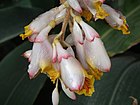Note: This is a project under development. The articles on this wiki are just being initiated and broadly incomplete. You can Help creating new pages.
Difference between revisions of "Elettaria cardamomum - Ela, Cardamom"
| Line 1: | Line 1: | ||
| − | [[File: | + | [[File:Plant Elettaria cardamomum P1110619 03.jpg|thumb|right|''Elaichi'', ''Elettaria cardomamum'']] |
'''Elettaria cardamomum''' is a herbaceous perennial plant in the ginger family. It is native to southern India. It is the most common of the species whose seeds are used as a spice called cardamom. It is cultivated widely in tropical regions and reportedly naturalized in Réunion, Indochina and Costa Rica. | '''Elettaria cardamomum''' is a herbaceous perennial plant in the ginger family. It is native to southern India. It is the most common of the species whose seeds are used as a spice called cardamom. It is cultivated widely in tropical regions and reportedly naturalized in Réunion, Indochina and Costa Rica. | ||
==Uses== | ==Uses== | ||
| Line 70: | Line 70: | ||
Cardamom flowers.jpg|Buds | Cardamom flowers.jpg|Buds | ||
Cardamom inflorescence and fruit IMG20170901151029.jpg|At field | Cardamom inflorescence and fruit IMG20170901151029.jpg|At field | ||
| + | Elettaria cardamomum Maton.jpg | ||
| + | Colour-&-Pattern.gif | ||
| + | Elettaria cardamomum (Cardamon) tree in RDA, Bogra 01.jpg | ||
</gallery> | </gallery> | ||
Revision as of 12:33, 4 April 2022
Elettaria cardamomum is a herbaceous perennial plant in the ginger family. It is native to southern India. It is the most common of the species whose seeds are used as a spice called cardamom. It is cultivated widely in tropical regions and reportedly naturalized in Réunion, Indochina and Costa Rica.
Contents
- 1 Uses
- 2 Parts Used
- 3 Chemical Composition
- 4 Common names
- 5 Properties
- 6 Habit
- 7 Identification
- 8 List of Ayurvedic medicine in which the herb is used
- 9 Where to get the saplings
- 10 Mode of Propagation
- 11 How to plant/cultivate
- 12 Commonly seen growing in areas
- 13 Photo Gallery
- 14 References
- 15 External Links
Uses
Indigestion, Nausea, Vomiting, Pulmonary disease, Stomachache, Heart burn, Throat troubles, Congestion of the lungs, Kidney stones[1]
Parts Used
Chemical Composition
The main chemical components of cardamom oil are a-pinene, b-pinene, sabinene, myrcene, a-phellandrene, limonene.[2]
Common names
| Language | Common name |
|---|---|
| Kannada | Elakki |
| Hindi | Elaichi |
| Malayalam | Elatarri |
| Tamil | Elam Ancha |
| Telugu | Elaki |
| Marathi | NA |
| Gujarathi | NA |
| Punjabi | NA |
| Kashmiri | NA |
| Sanskrit | Trutih |
| English | Cardamom, Malabar cardamom |
Properties
Reference: Dravya - Substance, Rasa - Taste, Guna - Qualities, Veerya - Potency, Vipaka - Post-digesion effect, Karma - Pharmacological activity, Prabhava - Therepeutics.
Dravya
Rasa
Katu (Pungent), Madhur (Sweet)
Guna
Laghu (Light), Ruksha (Dry)
Veerya
Sheet (cold)
Vipaka
Katu (Pungent)
Karma
Kapha, Vata
Prabhava
Habit
Identification
Leaf
| Kind | Shape | Feature |
|---|---|---|
| Simple | Long and sword-shaped | The underside is paler and may have a covering of tiny hairs and it is Dark green |
Flower
| Type | Size | Color and composition | Stamen | More information |
|---|---|---|---|---|
| Unisexual | Reach over 1 m in length | Pale green | 5-20 | The flowers contain both male and female parts. One of the petals is white and streaked with violet. Flowering from April to August |
Fruit
| Type | Size | Mass | Appearance | Seeds | More information |
|---|---|---|---|---|---|
| Oval | Each fruit has three chambers filled with small aromatic seeds, each about 3 mm long | The fruits dry to a straw-brown colour and are widely used as flavouring | Seeds dry to a straw-brown colour and are widely used as flavouring | Fruiting from September to January |
Other features
List of Ayurvedic medicine in which the herb is used
Where to get the saplings
Mode of Propagation
How to plant/cultivate
The planting is carried out during the rainy season commencing from June. Seedlings are to be planted upto the collar region for better growth.[5]
Commonly seen growing in areas
Subtropical area, Indoors in a heated greenhouse, Warm shady humid place.
Photo Gallery
References
- ↑ Karnataka Medicinal Plants Volume - 2 by Dr.M. R. Gurudeva, Page No. 117
- ↑ Plant Chemicals
- ↑ Leaf morphology
- ↑ Ayurvedic preparations
- ↑ Cultivation details
External Links
- Ayurvedic Herbs known to be helpful to treat Indigestion
- Ayurvedic Herbs known to be helpful to treat Nausea
- Ayurvedic Herbs known to be helpful to treat Vomiting
- Ayurvedic Herbs known to be helpful to treat Pulmonary disease
- Ayurvedic Herbs known to be helpful to treat Stomachache
- Ayurvedic Herbs known to be helpful to treat Heart burn
- Ayurvedic Herbs known to be helpful to treat Throat troubles
- Ayurvedic Herbs known to be helpful to treat Congestion of the lungs
- Ayurvedic Herbs known to be helpful to treat Kidney stones
- Herbs with Seeds used in medicine
- Herbs with Fruits used in medicine
- Herbs with common name in Kannada
- Herbs with common name in Hindi
- Herbs with common name in Malayalam
- Herbs with common name in Tamil
- Herbs with common name in Telugu
- Herbs with common name in Sanskrit
- Herbs with common name in English
- Habit - Herb
- Index of Plants which can be propagated by Seeds
- Index of Plants which can be propagated by Cuttings
- Herbs that are commonly seen in the region of Subtropical area
- Herbs that are commonly seen in the region of Indoors in a heated greenhouse
- Herbs that are commonly seen in the region of Warm shady humid place
- Herbs
- Zingiberaceae










